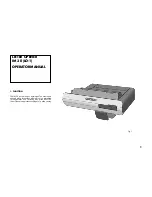
En
glis
h
52
Maintain force, static
If the "Maintain force, static" function is acti-
vated, the patient is required to maintain the
requested force for 4 seconds. The carriage
will not move during this period, it stands still
(static).
A progress bar in the dialog window indicates
the elapsed time. The progress bar fills only as
long as the patient exerts the required force.
When the progress bar is filled (after a total of 4
seconds of exerted force), the passive move-
ment of the joint is continued in the current
direction of motion.
This is the symbol for the "Maintain force, static"
function:
Maintain force, dynamic
If the "Maintain force, dynamic" function is
activated, the patient is required to maintain the
requested force for 4 seconds.
Contrary to the "Maintain force, static" function,
however, the patient will continue to move the
carriage actively (dynamic).
A progress bar in the dialog window indicates
the elapsed time. The progress bar fills only as
long as the patient exerts the required force.
When the progress bar is filled (after a total of 4
seconds of exerted force), the passive move-
ment of the joint is continued in the current
direction of motion.
This is the symbol for the "Maintain force, dy-
namic" function:
6.3.1.1 Adjustable parameters
in the "maintain force"
protocols
The following treatment parameters can be ad-
justed in the "hold force" coordination protocols:
Passive extension
(stretching) adjustment
Passive flexion (bending)
adjustment
Therapy timer
Speed
Warm-up protocol
(passive)
Extension pause
Flexion pause
Active adjustment (ROM
- range of motion)
Active zone
Extension force range
Flexion force range
Load reversal (passive)
Supplied by EME Services Ltd
















































